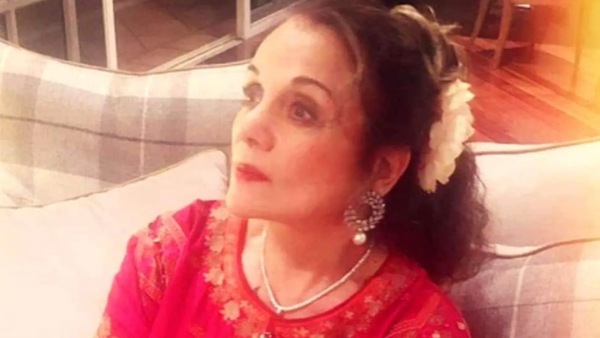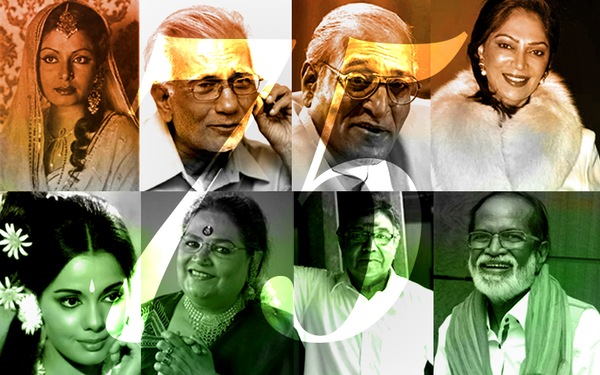National Treasures: Indian Cinema’s Batch of 1947

- Team FC
Film Companion
Last Updated: 11.50 PM, Aug 16, 2022

A sex symbol. A celebrated chat show host. An influential cinematographer. The director of one of our most beloved cult classics. The people featured in this list have little in common, apart from the fact that they were all born in the year of India’s independence, and that they are all icons in their own right. Some of these national treasures turn 75 on our 75th year of independence; others would have if they were still with us. Either way, it’s a good occasion to celebrate their contribution to the cultural melting pot that is Indian cinema.
Birthday: 19 February
The much-loved Tamil actor was best known for his comedic supporting roles in films like Kadhal Kottai (1996), Ghilli (2004), Pokkiri (2007) and more. There was more to him though. For example, he was a graduate of the National School of Design and had designed the logo of the All India Anna Dravida Munnetra Kazhagam (AIADMK). Instantly recognisable for his unique voice and mannerisms, he acted in hundreds of movies in the Nineties and 2000s. He passed away last year due to Covid-related complications.
Death: 6 May 2021

Birthday: 14 March
For an entire generation, T.S.B.K. Moulee is the name that comes to mind for having directed the supremely re-watchable Kamal Haasan comedy, Pammal K. Sambandam (2002). You may even recognise the man as a solid supporting actor seen most recently in Madhavan’s Maara (2021). This playwright-turned-filmmaker has made more than 30 films in two languages that include hits like Matravai Neril (1980), Patnam Vachina Pativrathalu (1982) and Ashwini (1991). As a writer, he is known for his comedies and he’s even written the comedic portions in the films of other directors, including the great K. Balachander. His most recent film as director was the Madhavan starrer Nala Damayanthi (2003), which was later remade in Hindi as Ramji Londonwaley (2005).

Famous for his cowboy hat and for the way he used light, Ashok Mehta was a legend who made his mark on both commercial and art house cinema. Perhaps one day, someone will make a biopic about this man who was born in Kandahar, Afghanistan, left home as a teenager, and sold boiled eggs on the streets of Mumbai before finding himself in the film industry. Mehta’s foray into cinematography happened by chance. He was a cameraman carrying equipment for Shyam Benegal’s documentary Close To Nature (1967) when its cinematographer had to leave after contracting malaria. Mehta stepped up and over the next four decades, he’d create some of Hindi cinema’s finest visuals. The subdued colour cinematography of 36 Chowringhee Lane (1981), for which he won the National Award; the soft lamp-lit glow of Girish Karnad’s Utsav (1984); and the stark harshness of the landscape in Bandit Queen (1994) — Mehta’s eye for visuals introduced audiences everywhere to new ways of seeing.
Death: 15 August 2012

Birthday: 6 June
Suthi Veerabhadra Rao was one of the most familiar faces in Telugu films in the Eighties. In eight years, he acted in more than 200 films as a comedian and character artist. He became particularly popular with the success of Nalugu Stambhalata (1982) and was best known for his dialogue delivery. Before entering the film industry, he was a theatre actor and had worked as a radio artist with All India Radio. Rao did a number of radio plays with stalwarts of Telugu theatre and literature and was known for being an avid reader.
Death: 30 June 1988

Birthday: 10 July
An industry veteran with a career spanning four decades, the Padma Shri awardee made his debut in the Telugu film industry in 1978 and remains popular. Rao started out as a theatre artist and his performance as a villain in a number of films caught the audiences’ attention. Movies like Ganesh (1998), Saamy (2003), Aa Naluguru (2004), Sarkar (2018) and S/O Satyamurthy (2015) show the actor’s versatility. In the Nineties, he added politics to his repertoire and served as a legislator from 1999 to 2004.

Birthday: 23 July
A constant, sobering presence in Indian cinema, Agashe’s distinctive face is carved in our collective movie-watching consciousness. He started appearing in films regularly around the time the parallel film movement was gaining momentum, in the mid-Seventies. His latest is the Marathi web series, B.E. Rojgaar, released last month. An important figure in Marathi theatre, he received the Sangeet Natak Academy award in 1996. He has also been a psychiatrist of considerable influence (his work in mental health has brought policy-level changes).

Birthday: 31 July
Mumtaz made her debut at the tender age of 11, became a ‘stunt heroine’ in action films, and by the time the Seventies rolled around, she was a bona fide sex symbol. Known for her unconventional features (including having a “pug nose” and “thunder thighs”) and formidable dancing skills, the actress went on to pioneer fashion trends – her low-waist, orange saree from the song “Aaj Kal Tere Mere Pyaar Ke Charche” from Brahmachari (1968) gave birth to the “Mumtaz Saree” phenomenon. At 26, when she was at the top of her game, Mumtaz retired from the movies and settled into married life. Thirteen years later, she was seen playing a cool mom in Aandhiyan (1990). The actress is now rumoured to be a part of director Sanjay Leela Bhansali’s highly-anticipated Netflix series Heeramandi, based on the lives of pre-Independence era courtesans.

Birthday: 15 August
You know all those cheesy lines about eyes being a window to the soul? When Rakhee looked straight into the camera, they felt true. Despite having no connections in either the Bengali or Hindi film industries, she rose to fame and was at one point, the highest-paid actress in Bollywood. When she decided to become an actress, she dropped her surname and her first film was in Bengali — Badhu Bharan (1967). She’d star in her first Hindi film Jeevan Mrityu (1970) soon after. Over three decades, she acted in approximately 91 movies. After Anil Sharma’s Shradhanjali (1981), Rakhee was offered several roles as the lead, but she surprised everyone by taking up dynamic character roles like that of Rajesh Khanna’s sister-in-law in Aanchal (1980) and Amitabh Bachchan’s mother in Shakti (1982). She won the Bengal Film Journalists’ Association (BFJA) Best Actress Award for Paroma (1985) and the National Film Award for Best Supporting Actress for Rituparno Ghosh’s Shubho Mahurat (2003), her last great performance. When she was asked in 2012 about being a recluse, Rakhee had responded with, “Why should I be in the public glare?… I love my independence.”

Birthday: October 17
“It’s a woman’s world” — the title of the show Simi Garewal hosted, produced and directed in 1986 for Doordarshan could well have been describing her own life. From working with movie greats like Mehboob Khan, Raj Kapoor, Satyajit Ray, Mrinal Sen, Raj Khosla and Yash Chopra, to hosting Rendezvous With Simi Garewal, one of the earliest chat shows on Indian television, Garewal has constantly evolved across mediums and kept up with the times. Famous for being the Lady in White, her interview show had guests like Imran Khan, Jackie Chan and Gayatri Devi and she got them to speak candidly. Garewal has since taken to YouTube, where her channel has nearly 500K subscribers.

Birthday: 19 October
The man who made Jaane Bhi Do Yaaro (1983). Need we say more? Shah’s debut feature film was a farcical black comedy that still stings and remains a textbook example of a cult classic. It was a flop at the time of release and gained a following over the years that continues to grow. His other works include Nukkad, Wagle Ki Duniya, and Circus — much-loved TV serials of a pre-liberalised India that he co-directed. Circus introduced Shah Rukh Khan to the world and Shah would go on to make Kabhi Haan Kabhi Naa (1994) with Khan. Shah’s last notable work was Kya Kehna (2000), starring Preity Zinta and Saif Ali Khan.
Death: 7 October 2017

Birthday: 4 November
Among the few heroines to remain active for close to six decades, Geethanjali acted in as many as 500 films in Telugu, Tamil, Malayalam and Hindi. Though she started working in films as a child actor, it was superstar N.T. Rama Rao who introduced her as a heroine in Rani Ratnaprabha (1960), which was directed by B.A. Subba Rao. Her noted roles were in hit Telugu films including Seeta Rama Kalyanam (1961), Doctor Chakravarthy (1964), Kalam Marindi (1972) and Illalu (1981). Her final performance was in the Telugu comedy That Is Mahalakshmi, an official remake of Queen (2013), which is as yet unreleased.
Death: 31 October 2019

Birthday: 7 November
Few voices are as iconic and instantly recognisable as Usha Uthup’s, with its peculiar mix of R&B influences and robust punch. Uthup began her career in the jazz age, singing in a club in Calcutta, and brought an attitude to filmi playback that was as unprecedented as it was bold and original. Her voice is an integral part of independent India’s sonic identity, its diversity and richness, starting from Hare Rama Hare Krishna, right through the disco era of the Eighties, to a rock number with an all-woman Shillong band in the more recent Rock On 2.

Birthday: 15 November
Vidya Sinha’s career in show business began with glamour. She was crowned Miss Bombay when she was 18 years old. However, what she’s remembered for is a look that was far more everyday — printed floral saris, sometimes a bindi, hoop earrings — but also charmingly elegant, and a defining image of the middle cinema of the Seventies. Sinha’s pleasant, easy presence in just Rajnigandha (1974) and Chhoti Si Baat (1976) makes her an unforgettable leading lady of Hindi cinema. In these films directed by Basu Chatterjee, Sinha created a picture of simplicity that is hard to come by today. She went on to do bigger, more mainstream films later, including a role in Salman Khan’s Bodyguard (2011).
Death: 15 August 2019

Birthday: 8 December
Few icons of Tamil cinema are known for as many of their crafts as Gangai Amaran. Ilaiyaraaja’s younger brother, Amaran has been a singer, composer, filmmaker and writer in the Tamil film industry. While he began his career in the Eighties by composing earworms for films such as K Bhagyaraj’s Mouna Geethangal (1981) and Kamal Haasan’s Vaazhvey Maayam (1982), Amaran made his directorial debut with Prabhu-starrer Kozhi Koovuthu (1982). One of his most successful works is as a filmmaker — Karakattakkaran (1989), starring Ramarajan and Kanaka. The film’s light-hearted sections involve Goundamani and Senthil, and are among these comedy giants’ most adored work. Amaran also penned the lyrics for some of his brother’s songs, including “Sendhoora Poove” and “En Iniya Pon Nilave”.

